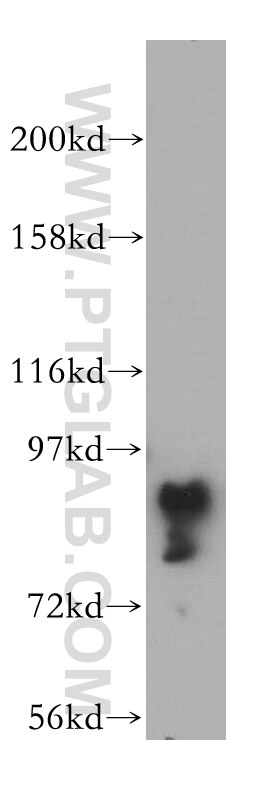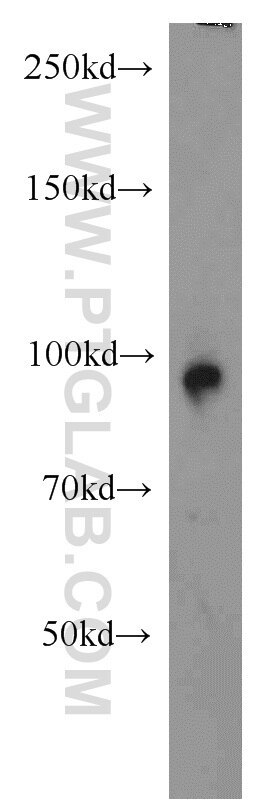Anticorps Polyclonal de lapin anti-GRAF
GRAF Polyclonal Antibody for WB, IP, IHC, ELISA
Hôte / Isotype
Lapin / IgG
Réactivité testée
Humain, souris
Applications
WB, IP, IHC, CoIP, ELISA
Conjugaison
Non conjugué
N° de cat : 17747-1-AP
Synonymes
Galerie de données de validation
Applications testées
| Résultats positifs en WB | cellules HeLa, cellules HepG2, tissu cérébral humain, tissu de thymus de souris |
| Résultats positifs en IP | cellules HepG2 |
| Résultats positifs en IHC | tissu hépatique humain, tissu cardiaque humain il est suggéré de démasquer l'antigène avec un tampon de TE buffer pH 9.0; (*) À défaut, 'le démasquage de l'antigène peut être 'effectué avec un tampon citrate pH 6,0. |
Dilution recommandée
| Application | Dilution |
|---|---|
| Western Blot (WB) | WB : 1:500-1:2000 |
| Immunoprécipitation (IP) | IP : 0.5-4.0 ug for 1.0-3.0 mg of total protein lysate |
| Immunohistochimie (IHC) | IHC : 1:20-1:200 |
| It is recommended that this reagent should be titrated in each testing system to obtain optimal results. | |
| Sample-dependent, check data in validation data gallery | |
Applications publiées
| WB | See 3 publications below |
| IHC | See 1 publications below |
| CoIP | See 1 publications below |
Informations sur le produit
17747-1-AP cible GRAF dans les applications de WB, IP, IHC, CoIP, ELISA et montre une réactivité avec des échantillons Humain, souris
| Réactivité | Humain, souris |
| Réactivité citée | Humain, souris |
| Hôte / Isotype | Lapin / IgG |
| Clonalité | Polyclonal |
| Type | Anticorps |
| Immunogène | GRAF Protéine recombinante Ag12008 |
| Nom complet | Rho GTPase activating protein 26 |
| Masse moléculaire calculée | 759 aa, 86 kDa |
| Poids moléculaire observé | 92 kDa |
| Numéro d’acquisition GenBank | BC068555 |
| Symbole du gène | ARHGAP26 |
| Identification du gène (NCBI) | 23092 |
| Conjugaison | Non conjugué |
| Forme | Liquide |
| Méthode de purification | Purification par affinité contre l'antigène |
| Tampon de stockage | PBS avec azoture de sodium à 0,02 % et glycérol à 50 % pH 7,3 |
| Conditions de stockage | Stocker à -20°C. Stable pendant un an après l'expédition. L'aliquotage n'est pas nécessaire pour le stockage à -20oC Les 20ul contiennent 0,1% de BSA. |
Informations générales
GTPase Regulator Associated with Focal Adhesion Kinase (GRAF), also known as Rho GTPase activating protein 26 (ARHGAP26) , is a GTPase-activating protein and inhibits the activity of Rho GTPases by promoting the hydrolytic ability of Rho GTPases. GRAF enhances the hydrolysis of GTPases and converts GTPases from an active form to an inactive form, thereby inhibiting signaling transduction. Deletion and mutation of GRAF can lead to promyelocytic leukemia, suggesting tumor suppressive activity of GRAF. GRAF was downregulated in glioblastoma and associated with cell proliferation and migration (PMID: 10908648, PMID: 17611651, PMID: 31004081). It has been reported that there are three splicing mutants of GRAF, namely GRAF1a (92 kDa),GRAF1b (86 kDa) and GRAF1c (75-82 kDa), and GRAF1b and GRAF1c are the major GRAF1 isoforms in adult brain, whereas GRAF1a is abundant in neonates(PMID: 35624318, PMID: 30626696).
Protocole
| Product Specific Protocols | |
|---|---|
| WB protocol for GRAF antibody 17747-1-AP | Download protocol |
| IHC protocol for GRAF antibody 17747-1-AP | Download protocol |
| IP protocol for GRAF antibody 17747-1-AP | Download protocol |
| Standard Protocols | |
|---|---|
| Click here to view our Standard Protocols |
Publications
| Species | Application | Title |
|---|---|---|
J Neurol Rho GTPase-activating protein 10 (ARHGAP10/GRAF2) is a novel autoantibody target in patients with autoimmune encephalitis | ||
Brain Res Deficiency of NEAT1 prevented MPP+-induced inflammatory response, oxidative stress and apoptosis in dopaminergic SK-N-SH neuroblastoma cells via miR-1277-5p/ARHGAP26 axis. | ||
Cell Death Dis CEMIP, acting as a scaffold protein for bridging GRAF1 and MIB1, promotes colorectal cancer metastasis via activating CDC42/MAPK pathway |
Avis
The reviews below have been submitted by verified Proteintech customers who received an incentive forproviding their feedback.
FH Cicek (Verified Customer) (06-11-2024) | I used this antibody on mouse neurons, iPSCs and iNeurons with Western blotting, using beta-actin as positive control. There were specific bands at 90 kDa mark for iPSCs and iNeurons, but not for mouse neurons. It was highly expressed in iNeurons. There were unspecific bands at the 70 kDa mark for all samples.
|










